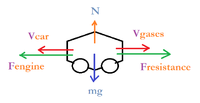A car of mass [MATH]600 \ kg[/MATH] is driven along a straight road. The resistance to motion of the car is [MATH]kv^2[/MATH] Newtons, where [MATH]v \ m/s[/MATH] is the velocity of the car at time [MATH]t[/MATH] seconds and [MATH]k[/MATH] is a constant. The engine of the car is producing [MATH]8 \ kW[/MATH] of output power.
A.
i. Draw a free body diagram of the system.
ii. Derive the differential equation of motion of the vehicle, and describe it in the form:
[MATH]\frac{dv}{dt} + Av^2 - \frac{B}{v} = 0[/MATH]Where [MATH]A[/MATH] and [MATH]B[/MATH] are constants to be found.
B. When the velocity of the car is [MATH]20 \ m/s[/MATH], the engine is turned off.
i. Draw a free body diagram of the system.
ii. Derive the differential equation of motion of the car, and describe it in the form:
[MATH]\frac{dv}{dt} + Av^2 = 0[/MATH]Where [MATH]A[/MATH] is a constant to be found.
iii. Find, in term of [MATH]k[/MATH], an expression for the velocity of the car. Make sure your expression is in the form [MATH]v = f(t)[/MATH]
This is what I did for [MATH]A[/MATH]

I am not sure if this is the correct free body diagram. Can anyone help me, please?
Now, I will try to derive the differential equation.
[MATH]F_e - F_R = ma = m\frac{dv}{dt}[/MATH]
[MATH]m\frac{dv}{dt} + kv^2 - F_e = 0[/MATH]
Now I will use the output power
[MATH]F_e = \frac{P}{v}[/MATH]
[MATH]m\frac{dv}{dt} + kv^2 - \frac{P}{v} = 0[/MATH]
[MATH]\frac{dv}{dt} + \frac{kv^2}{m} - \frac{P}{mv} = 0[/MATH]
Is this a correct derivation? Please, let me know if I did something wrong in the derivation or in the free body diagram.
I also noticed that if I want to solve this differential equation with separable method, it gives a very complicated solution while wolfram can solve it easily [MATH]v(t) = -Atv^2 + \frac{Bt}{y} + c_1[/MATH], if I let [MATH]A = \frac{k}{m}[/MATH] and [MATH]B = \frac{P}{m}[/MATH]
Why is that?
A.
i. Draw a free body diagram of the system.
ii. Derive the differential equation of motion of the vehicle, and describe it in the form:
[MATH]\frac{dv}{dt} + Av^2 - \frac{B}{v} = 0[/MATH]Where [MATH]A[/MATH] and [MATH]B[/MATH] are constants to be found.
B. When the velocity of the car is [MATH]20 \ m/s[/MATH], the engine is turned off.
i. Draw a free body diagram of the system.
ii. Derive the differential equation of motion of the car, and describe it in the form:
[MATH]\frac{dv}{dt} + Av^2 = 0[/MATH]Where [MATH]A[/MATH] is a constant to be found.
iii. Find, in term of [MATH]k[/MATH], an expression for the velocity of the car. Make sure your expression is in the form [MATH]v = f(t)[/MATH]
This is what I did for [MATH]A[/MATH]

I am not sure if this is the correct free body diagram. Can anyone help me, please?
Now, I will try to derive the differential equation.
[MATH]F_e - F_R = ma = m\frac{dv}{dt}[/MATH]
[MATH]m\frac{dv}{dt} + kv^2 - F_e = 0[/MATH]
Now I will use the output power
[MATH]F_e = \frac{P}{v}[/MATH]
[MATH]m\frac{dv}{dt} + kv^2 - \frac{P}{v} = 0[/MATH]
[MATH]\frac{dv}{dt} + \frac{kv^2}{m} - \frac{P}{mv} = 0[/MATH]
Is this a correct derivation? Please, let me know if I did something wrong in the derivation or in the free body diagram.
I also noticed that if I want to solve this differential equation with separable method, it gives a very complicated solution while wolfram can solve it easily [MATH]v(t) = -Atv^2 + \frac{Bt}{y} + c_1[/MATH], if I let [MATH]A = \frac{k}{m}[/MATH] and [MATH]B = \frac{P}{m}[/MATH]
Why is that?

